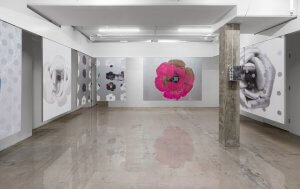Lorenza Longhi: World of Yum Yum | Mousse
Feb 20 2024

By editors
Lorenza Longhi “World of Yum Yum” at Swiss Institute, New York
“World of Yum Yum” is the first solo exhibition in the US by artist Lorenza Longhi, featuring newly commissioned paintings and sculptures in a site-specific installation. Through architectural interventions and a visual language that enlists both strategies of luxury advertising, merchandising and commerce, along with craft and DIY techniques, Longhi’s work considers spaces of display and the desires they engender. Taking its inspiration from a temporary exhibition space that Longhi encountered in an airport, “World of Yum Yum” features a series of hyperreal closeups of artificial hand-made flowers, reminiscent of Chanel brooches, on movable panels that hang from tracks on the ceiling. Appearing as blown-up photographs pasted like posters and silk-screened with overlay patterns of flower outlines and dots, each brooch’s center holds a spy camera that peeps outwards.
“Rigorously speaking, no one wants to be subject of the gaze, we all want to be fabulous objects,” critic Rhonda Lieberman writes in a 1992 essay entitled The Loser Thing. “Commodities promise to lift and separate people from feelings of inadequacy and unloveliness, but they can also betray us, give us dirty looks, and make us feel unworthy of them.” 1 The eyes of the camellias affixed to Longhi’s panels can shift within the hanging apparatus, opening new spaces and gaps for visibility or escape. While some stare directly, others give a side-eye squint. Let’s get personal, they seem to suggest. Lieberman’s Glamour Wounds column, written two months later, on Coco Chanel, her brand and the demoralizing experience of visiting the Chanel boutique, or as she describes it, “the world of yum-yum: a shop full of dazzling absurd phalluses fully equipped to beam you up and save you,” examines the impulse for masochistically identifying with these luxury objects and finding relief through the joy of degradation from their indifference. Failure to become the commodity, she writes, “is impossible to symbolize; you can only circle around it in interpretative impotence. Or buy it, if possible.” 2
The flowers portrayed in Longhi’s images are actual sculptures, each containing a working camera. She constructs them herself from scrap fabric she has found or collected by following YouTube instructions for making Chanel camellias. For this exhibition, the small flower sculptures were photographed by Longhi along with two professional photographers and enlarged significantly. The quality of the photos varies depending on the photographer’s eye and camera. Some are crisp, while others are smooth, muddy, or poor, resembling AI-generated images. Longhi’s primary interest is not photographic fidelity, but rather the proximity and texture of the surface of the objects, their materiality. The evidence of their private act of making takes precedence.
Longhi used the spy camera’s microphone to record atmospheric sounds of music as she strolled through department stores in Zürich, where she lives, and New York. She additionally positioned multiple speakers playing various pop songs throughout her studio and apartment, and recorded the panoply of shifting soundtracks as she walked past them with the same spy device. A mix of the resulting audio plays in the exhibition on directional speakers located within wall-mounted boxes that are covered in florist’s kraft paper, as well as reproductions of the same paper, and printed silkscreen mesh she previously used for the paintings. Passing by, it almost sounds like shopping.
1 Rhonda Lieberman, “The Loser Thing,” Artforum, September 1992, p. 80.
2 Rhonda Lieberman, “Glamour Wounds: The Chanel Superego,” Artforum, November 1992, p. 6.
at Swiss Institute, New York
until April 14, 2024
